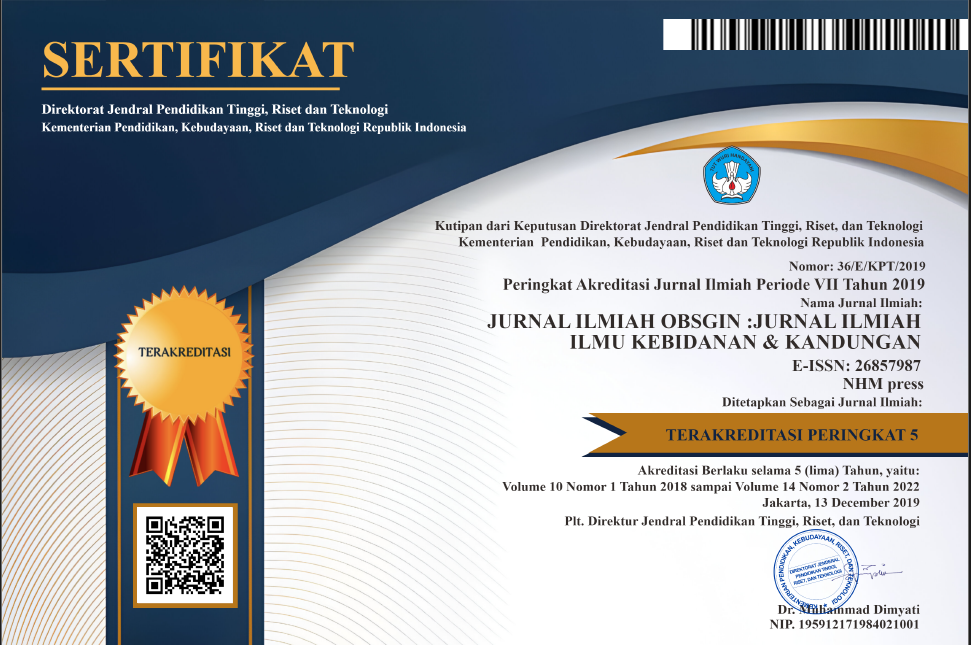PENGARUH VIDEO ANIMASI TERHADAP PENGETAHUAN IBU HAMIL TRIMESTER III TENTANG ASI EKSKLUSIF DI WILAYAH KERJA PUSKESMAS DENDANG
Abstract
The coverage of exclusive breastfeeding nationally in Indonesia is 61.33%. One of the efforts to increase the percentage of exclusive breastfeeding is by conducting health education that can be done since pregnancy in order to prepare for early breastfeeding. Quasy experimental research design which is one group pretest-posttest to determine the effect of animated video media on the knowledge of third trimester pregnant women about exclusive breastfeeding. This research was conducted in the Dendang Health Center Work Area in February-June 2022. The sample of this study was 67 pregnant women using total sampling technique. The instrument used in this research is filling out a questionnaire. The statistical test used to analyze the data for the two variables was using T-Test with a significance level of 5%. The results showed that before being given an animated video about exclusive breastfeeding, most of the respondents had poor knowledge and after being given an animated video about exclusive breastfeeding, most of the respondents had good knowledge. The statistical test results obtained a p-value of 0.000 which means that there is a significant influence between animated videos on the knowledge of third trimester pregnant women about exclusive breastfeeding. The conclusion of the study is that there is a significant effect between animated videos on the knowledge of third trimester pregnant women about exclusive breastfeeding
References
Afriani, R. (2018). Hubungan Dukungan Sosial dan Sikap Ibu terhadap Keberhasilan Pemberian ASI Eksklusif Di Wilayah Puskesmas Benao Kabupaten Barito Utara Kalimantan Tengah. Universitas Airlangga.
Ahdal, M. T., Sirajuddin, S., & Alharini, S. (2014). Hubungan Infeksi Kecacingan Dengan Status Gizi Pada Anak SDN Cambaya Di Wilayah Pesisir Kota Makassar. Universitas Hasanuddin Fakultas Kesehatan Masyarakat, 1(1), 1–4.
Ahmed, K. Y., Page, A., Arora, A., & Ogbo, F. A. (2019). Trends and determinants of early initiation of breastfeeding and exclusive breastfeeding in Ethiopia from 2000 to 2016. International Breastfeeding Journal, 14(1), 1–14.
Alwi, M. K., & Asrina, A. (2021). Perbedaan Pengaruh Media Lembar Balik dan Kartu Kendali Edukasi Terhadap Pengetahuan Dan Sikap Ibu Menyusui Tentang ASI Ekslusif Di Wilayah Kerja Puskesmas Koppe Kabupaten Bone. Journal of Aafiyah Health Research (JAHR), 2(1), 91–102.
Amalia, R., & Rizki, L. K. (2018). Faktor Faktor yang Mempengaruhi Keberhasilan Ibu Bekerja Dalam Pemberian ASI Eksklusif. Mandala Of Health: A Scientific Journal, 11(1), 44–51.
Anita, Wantania, J., & Korompis, M. (2016). Hubungan Antara Pengetahuan Ibu, Fasilitas Pelayanan Kesehatan, Dukungan Keluarga Dan Dukungan Petugas Dengan Pemberian Asi Ekslusif 6 Bulan Di Wilayah Kerja Puskesmas Pangolombian Kecamatan Tomohon Selatan. Paradigma, 4(2).
Anwar, C., Annisa, S., Dalilah, D., & Novrikasari, N. (2018). The relationship between soil transmitted helminthes (STH) infection and nutritional status in students of state elementary school number (SDN) 200 Palembang Indonesia. Bioscientia Medicina: Journal of Biomedicine and Translational Research, 2(2), 42–53.
Aprilia, D., & Fitriah, A. (2017). Efektivitas Kelas Edukasi (KE) Menyusui untuk Meningkatkan Efikasi Diri Ibu Menyusui dalam Memberikan ASI Ekslusif di Banjarmasin. Mu’adalah; Jurnal Studi Gender Dan Anak, 4(2).
Arifeen, S., Black, R. E., Antelman, G., Baqui, A., Caulfield, L., & Becker, S. (2001). Exclusive breastfeeding reduces acute respiratory infection and diarrhea deaths among infants in Dhaka slums. Pediatrics, 108(4), e67–e67.
Ariwati, V. D., Rosyidi, M. I., & Pranowowati, P. (2014). Hubungan Dukungan Bidan tentang Pemberian ASI Eksklusif dengan Perilaku Pemberian ASI Eksklusif di Wilayah Kerja Puskesmas Ambarawa Kabupaten Semarang. STIKES Ngudi Waluyo Ung.
Awanda Putri, N., & Puspowati, S. D. (2019). Pengaruh penyuluhan dengan media lembar balik (flip chart) terhadap pengetahuan dan sikap ibu hamil tentang asi eksklusif di puskesmas tuban kabupaten tuban. Universitas Muhammadiyah Surakarta.
Aziezah, N., & Adriani, M. (2018). Perbedaan tingkat konsumsi dan status gizi antara bayi dengan pemberian ASI eksklusif dan non ASI eksklusif. Media Gizi Indonesia, 9(1), 78–83.
Batubara, N. S. (2016). Pengaruh Sosial Budaya Terhadap Pemberian ASI Eksklusif di Wilayah Kerja Puskesmas Batunadua Kota Padangsidimpuan Tahun 2015. Jurnal Kesehatan Ilmiah Indonesia (Indonesian Health Scientific Journal), 1(1), 59–66.
Boateng, M. (2018). Knowledge, attitude and practice of exclusive breastfeeding among mothers in Techiman, Ghana. Itä-Suomen yliopisto.
Buser, J. M., Moyer, C. A., Boyd, C. J., Zulu, D., Ngoma-Hazemba, A., Mtenje, J. T., Jones, A. D., & Lori, J. R. (2020). Cultural beliefs and health-seeking practices: Rural Zambians’ views on maternal-newborn care. Midwifery, 85, 102686. https://doi.org/10.1016/j.midw.2020.102686
Butte, N. F., Lopez-Alarcon, M. G., & Garza, C. (2002). Nutrient adequacy of exclusive breastfeeding for the term infant during the first six months of life. World Health Organization.
Cai, X., Wardlaw, T., & Brown, D. W. (2012). Global trends in exclusive breastfeeding. International Breastfeeding Journal, 7(1), 1–5. https://internationalbreastfeedingjournal.biomedcentral.com/track/pdf/10.1186/1746-4358-7-12.pdf
Cyntia Putri, R., & Puspowati, S. D. (2019). Pengaruh Penyuluhan Dengan Media Booklet Terhadap Pengetahuan Dan Sikap Ibu Hamil Tentang Asi Eksklusif Di Wilayah Binaan Puskesmas Baki Kabupaten Sukoharjo. Universitas Muhammadiyah Surakarta.
Danso, J. (2014). Examining the practice of exclusive breastfeeding among professional working mothers in Kumasi metropolis of Ghana. International Journal of Nursing, 1(1), 11–24.
Dennis, C. L., Fung, K., Grigoriadis, S., Robinson, G. E., Romans, S., & Ross, L. (2007). Traditional postpartum practices and rituals: A qualitative systematic review. Women’s Health, 3(4), 487–502. https://doi.org/10.2217/17455057.3.4.487
Department of Health Jambi Province. (2020). Profile Health Department of Health Jambi Province. http://dinkes.jambiprov.go.id/file/informasi_publik/MTYxNTE2NDQyOA_Wkt1615164428_XtLnBkZg.pdf
Deslima, N., Misnaniarti, M., & Zulkarnain, H. M. (2019). Analisis Hubungan Inisisi Menyusu Dini (IMD) Terhadap Pemberian ASI Eksklusif di Wilayah Kerja Puskesmas Makrayu Kota Palembang. JUMANTIK (Jurnal Ilmiah Penelitian Kesehatan), 4(1), 1–14.
Dukuzumuremyi, J. P. C., Acheampong, K., Abesig, J., & Luo, J. (2020). Knowledge, attitude, and practice of exclusive breastfeeding among mothers in East Africa: a systematic review. International Breastfeeding Journal, 15(1), 1–17.
Erwin, LA, A. L. . (2019). Cakupan dan Determinan Pemberian ASI Ekslusif di Pemukiman Kumuh Dalam Perkotaan di Kecamatan Tallo Kota Makassar. Majalah Kesehatan FKUB, 6(1), 44–55.
Fajar, N. A., Purnama, D. H., Destriatania, S., & Ningsih, N. (2018). Hubungan Pemberian ASI Eksklusif dalam Prespektif Sosial Budaya di Kota Palembang. JOURNAL-JIKM: JURNAL ILMU KESEHATAN MASYARAKAT, 9(3), 226–234.
Fatmawati, A. P., Kep, I. S., & Ns, M. (2013). Hubungan Status Ekonomi Orangtua Dengan Pemberian Asi Eksklusif Pada Bayi Usia 0-6 Bulan Di Baki Sukoharjo. Universitas Muhammadiyah Surakarta.
Fauzi, F. K. (2019). Hubungan antara Dukungan Keluargam Status Pekerjaan dan Paritas Ibu dengan Perilaku Pemberian ASI Eksklusif. Jurnal Keperawatan Muhammadiyah, 4(2).
Felik, I. G. P. (2013). Hubungan antara Karakteristik Ibu dan Pemberian Asi Eksklusif. Jurnal Mahasiswa PSPD FK Universitas Tanjungpura, 1(1).
Giri, I. A., & Dian, A. (2013). Determinan Perilaku Pemberian ASI Eksklusif Pada Ibu Bekerja. UI. Jurnal Kesmas Nasional, 7(7).
Indonesian Ministry of Health Data and Information Center. (2014). Situation and Analysis of Exclusive Breastfeeding 2014.
Infodatin Kemenkes RI. (2014). Situasi Dan Analisis ASI Eksklusif 2014. Pusat Data dan Informasi Kementerian Kesehatan RI.
Kusnan, A., Binekada, I. M. C., & Usman, A. N. (2020). The proxy determinant of complementary feeding of the breastfed child delivery in less than 6 months old infant in the fishing community of Buton tribe. Enfermeria Clinica, 30, 544–547.
Notoatmodjo, S. (2014). Ilmu Perilaku Kesehatan. Rineka Cipta.
Putri, B. D. Y., Herinawati, H., & Susilawati, E. (2021). Pengaruh Promosi Kesehatan Tentang Bounding Attachment Berbasis Video Animasi Terhadap Pengetahuan Ibu Hamil. Nursing Care and Health Technology Journal (NCHAT), 1(3), 155–161. https://doi.org/Http://ojs.nchat.id/index.php/nchat/article/view/27
Suryani, S., & Nadia, N. (2022). Peran Media Video Animasi Dalam Meningkatkan Pengetahuan Gizi Ibu Hamil. Nursing Care and Health Technology Journal (NCHAT), 2(1), 207–217.
Yulyana, N. (2017). Pengaruh video ASI eksklusif terhadap pengetahuan dan sikap ibu dalam memberikan asi eksklusif. Jurnal Kebidanan Besurek, 2(1), 13–25.
Yuni, M. S., Ruwayda, R., & Herinawati, H. (2021). Efektifitas Lembar Balik dan Video Animasi Terhadap Pengetahuan Primigravida tentang Persiapan Persalinan. Jurnal Kesehatan Komunitas, 7(3), 288–295.











